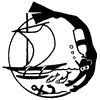 |
|
Maritime
Lanka
|
22 Feb 2003
|
|||
| Last modified: 22 Feb 2003 |
Many techniques have been tried over the centuries to prolong the life of ships' timbers. The Englishman Sir Richard Hawkins described those he knew(1), writing c.1620 about experience gained on a voyage which started in 1593.
And for that I have seene divers manners of sheating, for the ignorant I will set them downe which by experience I have found best.
In Spain and Portingall, some sheate their shippes with lead; which, besides the cost and waight, although they use the thinnest sheet-lead that I have seen in any place, yet it is not durable, but subject to many casualties.
Another manner is used with double plankes, as thicke without as within, after the manner of furring: which is little better then with lead; for, besides his waight it dureth little, because the worms in small time passeth through the one and the other.
A third manner of sheating hath beene used amongst some with fine canvas; wich is of small continuance, and so not to be regarded.
The fourth prevention, which is now most accompted of, is to burne the utter planke till it come to be in every place like a cole, and after to pitch it; this is not bad.
In China, as I have been informed, they use a certain betane [bitumen?] or varnish, in manner of an artificiall pitch, wherewith they trim the outside of their shippes. It is said to be durable, and of that vertue, as neither worme nor water peirceth it; neither has the sunne power against it.
Some have devised a certain pitch, mingled with glasse and other ingredients, beaten into powder, with which if the shippe be pitched, it is said the worme that touched it dyeth; but I have not heard that it hath been usefull.
But the most approved of all, now adayes in England, with thin bourdds, halfe inche thicke; the thinner the better; and elm better than oake; for it ryveth not, it endureth better under water, and yeeldeth better to the ships side. The invention of the materialles incorporated betwixt the planke and the sheating, is that which avayleth; for without it many plankes were not sufficient to hinder the entrance of of this worme; this manner is thus: Before the sheating board is nayled on, upon the inner side of it they smere it over with tarre halfe a finger thicke and upon the tarre anothe halfe finger of hayre, such as the whitelymers use, and so naylec it on, the nayles not above a spanne distance one from another; the thicker they are driven the better. Some hold opinion that the tarre killeth the worme; others that the worme passing the sheating, and seaking a way through, the hayre and the tarre so involve him that he is choked therewith; which me thinkes is most probable; this manner of sheating was invented by my father, and experience has taught it to be the best and of least cost.
| Maritime Lanka homepage |